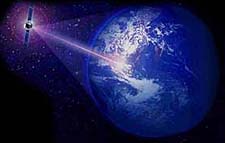(29d) Satellites with Commercial Missions
This groups includes about 200 communication satellites ("comsats") scattered in synchronous orbits above the Earth's equator. At a distance of 6. 6 Earth radii (42,000 km or 26,000 miles), these satellite make one orbit per day, and therefore as the Earth turns, they always stay above the same ground station. Comsats have become essential to the relaying of television broadcasts, long distance telephone connections and computer communications: if you are receiving this from the world-wide web (especially if you are outside the US) this document might well have been routed to you through one of them. NASA maintains several communication satellites as data links to other satellites, an arrangement found more economical than the use of tracking stations on the ground. In addition, networks of low-altitude communication satellites (e.g. "Iridium", a system of 66 spacecraft, plus spares) are being deployed for use by cellular telephones. Some beneficial satellites were already listed under different classifications: weather satellites, like those of the GOES series, and those which scan the Sun and the "solar wind" for activity affecting "space weather" inside the magnetosphere. Still another application is the 24-satellite network of the "Global Positioning System" (GPS), in circular orbits at distances of about 4.1 Earth radii (26,000 km or 16,000 miles). GPS satellites continually broadcast their precise locations, and these can be read by small portable receivers, relatively inexpensive. Using a built-in computer, these receivers then derive their own precise position on the ground, within 10-50 meters. Russia operates its own system, GLONASS, and European countries are planning a third one. Originally developed by the US Department of Defense (whose users derive from them even more precise positions), the GPS satellites are widely used by the public--by ships at sea, airplanes, hikers in the wilderness, even drivers trying to navigate large cities. |


